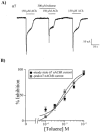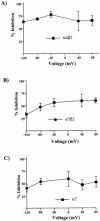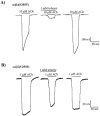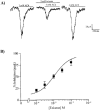Inhibition of neuronal nicotinic acetylcholine receptors by the abused solvent, toluene
- PMID: 12237258
- PMCID: PMC1573496
- DOI: 10.1038/sj.bjp.0704874
Inhibition of neuronal nicotinic acetylcholine receptors by the abused solvent, toluene
Abstract
1 Toluene is a representative example of a class of industrial solvents that are voluntarily inhaled as drugs of abuse. Previous data from this lab and others has shown that toluene modulates the function of N-methyl-D-aspartate (NMDA), gamma-aminobutyric acid (GABA) and glycine receptors at concentrations that do not affect non-NMDA receptors. 2 We utilized two-electrode voltage-clamp and whole cell patch-clamp techniques to assess the effects of toluene on neuronal nicotinic acetylcholine receptors expressed in oocytes and cultured hippocampal neurons. Toluene (50 micro M to 10 mM) produced a reversible, concentration-dependent inhibition of acetylcholine-induced current in Xenopus oocytes expressing various nicotinic receptor subtypes. The alpha4beta2 and alpha3beta2 subunit combinations were significantly more sensitive to toluene inhibition than the alpha4beta4, alpha3beta4 and alpha7 receptors. 3 Receptors composed of alpha4 and beta2(V253F) subunits showed alpha4beta4-like toluene sensitivity while those containing alpha4 and beta4(F255V) subunits showed alpha4beta2-like sensitivity. 4 In hippocampal neurons, toluene (50 micro M to 10 mM) dose-dependently inhibited ACh-mediated responses with an IC(50) of 1.1 mM. 5 Taken together, these results suggest that nicotinic receptors, like NMDA receptors, show a subunit-dependent sensitivity to toluene and may represent an important site of action for some of the neurobehavioural effects of toluene.
Figures








References
-
- AISTRUP G.L., MARZALEC W., NARAHASHI T. Ethanol modulation of nicotinic acetylcholine receptor currents in cultured cortical neurons. Mol. Pharmacol. 1999;55:39–49. - PubMed
-
- ALBUQUERQUE E.X., ALKONDON M., PEREIRA E.F.R., CASTRO N.G., SCHRATTENHOLZ A., BARBOSA C.T.F., BONFANTE-CARBARCAS R., ARACAVA Y., EISENBERG H.M., MAELICKE A. Properties of neuronal nicotinic acetylcholine receptors: Pharmacological characterization and modulation of synaptic function. J. Pharmacol. Exp. Ther. 1997;280:1117–1136. - PubMed
-
- ALKONDON M., PEREIRA E.F.R., ALBUQUERQUE E.X. Alpha-bungarotoxin- and methyllycaconitine-sensitive nicotinic receptors mediate fast synaptic transmission in interneurons of rat hippocampal slices. Brain Res. 1998;810:257–263. - PubMed
-
- AMENO K., KIRIU T., FUKE C., AMENO S., SHINOHARA T., IJIRI I. Regional brain distribution of toluene in rats and in a human autopsy. Arch. Toxicol. 1992;66:153–156. - PubMed
-
- BALE A.S., SMOTHERS C.T., BLEVINS T., WOODWARD J.J. Comparison of the mechanisms and sites of action of toluene and alcohol. Alcohol. Clin. Exp. Res. 2000;24:84A.
Publication types
MeSH terms
Substances
Grants and funding
LinkOut - more resources
Full Text Sources
Miscellaneous

